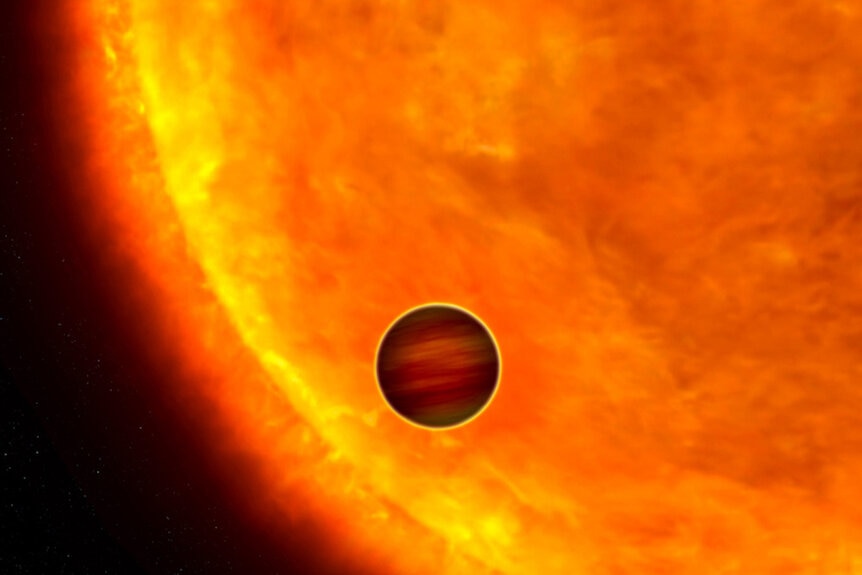Create a free profile to get unlimited access to exclusive videos, sweepstakes, and more!
Hubble looks at a planet where vaporized rock may rain out as molten rock at night
Better pack a titanium umbrella.

I used to live on the East Coast, and one of the reasons I moved away was because of the summer humidity. I couldn’t take it. It always felt like I was slowly melting.
Given that, I will be crossing WASP-178 b off my vacation spot list. The humidity there is arguably worse, if by humidity you mean atmospheric content of vaporized rock.
Yeah. New Hubble Space Telescope observations show that this gas giant planet is so hot that the atmosphere contains a significant amount of silicon monoxide (SiO), a common constituent in rocks [link to paper]. Not only that, it might — might — rain out as actual rock on the night side of the planet where it gets cooler, though the observations can neither confirm nor rule that out.
Just to be clear: It might rain molten rock on the night side of this planet.
WASP-178 is a star about 1,400 light-years from Earth, and it’s what we call an A-class star, nearly twice as massive as the Sun and much hotter, about 9,000°C versus the Sun’s 5,800°. The exoplanet WASP-178 b is about 70% more massive than Jupiter and 1.8 times its diameter. It orbits the star a scorching 7 million kilometers above the surface, where it’s heated to an incredible 2,220° C (4,000° F).
Holy yikes.
It’s one of the hottest exoplanets known. It was discovered via the transit method; its orbit is nearly edge-on as seen from Earth, so once every 3.3 days it passes directly in front of its host star, causing the light to dim a bit. That can be measured and used to determine the planet’s size and orbital size and shape.
But there’s more. While the light from the star is blocked by the bulk of the planet, the upper atmosphere thins out with distance from the planet center, and becomes partially transparent. That means that during a transit some of the star’s light passes through the planet’s atmosphere on its way to Earth.
Different elements and molecules absorb light at very specific wavelengths, so if you take a spectrum of a star during a planetary transit there will be dips in the light at those wavelengths where the light was absorbed by the planet’s atmospheric constituents.
Astronomers took advantage of this to use Hubble Space Telescope’s Wide-Field Camera 3 to observe a transit of WASP-178b in September 2020. They took spectra in the wavelengths of ultraviolet light, where many interesting elements absorb light.
What they found is that the amount of light they saw dropped significantly between wavelengths of 0.2 and 0.3 microns, in near-ultraviolet — wavelengths just outside what our eyes can see at the blue end. The drop in light was deeper than what was seen in visible light, indicating it’s from absorption.
We know how different elements and molecules absorb light, and so the astronomers used models of stuff typically found in planetary atmospheres at that temperature, and found the best fit was for silicon monoxide. In other words, it’s hot enough in the upper atmosphere of WASP-178b to vaporize SiO.
This is where things get interesting. During a transit we are facing the dark side of the planet, because it’s directly between us and the star, so we’re looking straight down on the midnight side of it. But on one side of the planet we’re looking through the part of the atmosphere where it’s dawn, and on the other side it’s dusk. Since the star is what’s heating the planet, you’d expect the dusk side to be hotter than the dawn side, because it’s been baking in sunlight for over a day.
But they see no evidence of that. The effect of this would be an asymmetry in the spectrum, but none was seen. That indicates that the upper atmosphere is pretty much the same temperature at sunset as it is at sunrise.
And that temperature is enough to keep SiO vaporized. If it cools at all on the night side of the planet, then it heats up extremely rapidly at sunrise. Or it may not cool enough to allow SiO to condense at all. If so, it doesn’t rain rocks on the night side of WASP-178 b, though again they can’t rule it out.
If this sounds exotic and bizarre, then think of someone who’s lived their whole life on, say, Antarctica, visiting Virginia (where I grew up) in August, where it commonly hits 38° C with a relative humidity in the upper 90s. Water is a vapor in the air, and it’s too hot to condense, maybe even at night. It doesn’t rain, but it feels like the air is trying to smother you.
That’s WASP-178 b, except Antarctica is Earth, and instead of water it’s vaporized rock. As I said before: Yikes.
The thing about exoplanets is, if you’ve seen one, you’ve seen one. They’re all very different from each other, with a staggering diversity that I don’t think astronomers really suspected until we started actually finding them in the 1990s. These broiling-hot gas giants skimming the surfaces of their stars are bizarre even among the exoplanetary menagerie, and there’s much we can learn from them. And we can use that knowledge to compare them to our own solar system planets to learn more about our local neighborhood, too.
It can be hard to learn about something when all you have is that one thing. Introduce diversity and suddenly you have examples of how things can be different, which is critical to understanding underlying environments and behaviors. Without that diversity, we only have a small part of the whole picture.
And hey, if there’s a morality lesson to be had there, then feel free to ponder it.




























